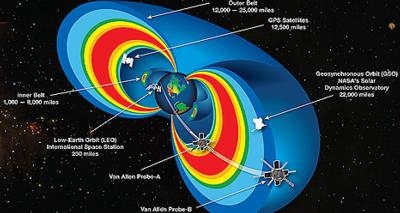Research Continues Six Decades After Launch Of Explorer 1
Tick, tick, tick. The device — a Geiger counter strapped to a miniature tape recorder — was registering radiation levels a thousand times greater than anyone expected. As the instrument moved higher, more than 900 miles above the surface, the counts ceased. Scientists were baffled. It was early 1958, the United States had just launched its first spacecraft, and a new discipline of physics was about to be born.

Sixty years ago today, the United States launched its first satellite into space. Dubbed Explorer 1, the spacecraft followed just months after the Soviet Union’s Sputnik 1 and 2 spacecraft commenced the Space Age. Data captured by the Geiger counter aboard Explorer 1 heralded the emergence of space physics and ushered in a new era of technology and communications.
Far above Earth’s atmosphere, the radiation picked up by the instrument aboard Explorer 1 wasn’t of Earthly origin. In fact, it was from a region scientists previously considered largely void of particles. Prior to launch, scientists expected to measure cosmic rays — high-energy particles primarily originating beyond the solar system — which they had previously studied with ground- and balloon-based instruments. But what they found far outpaced the levels of radiation that would be expected from cosmic rays alone.
The radiation recorded by Explorer 1 was humanity’s first glimpse of Earth’s radiation belts, two concentric rings of energetic particles surrounding the planet. The inner belt, composed predominantly of protons, and the outer belt, mostly electrons, would come to be named the Van Allen Belts, after James Van Allen, the scientist who led the charge designing the instruments and studying the radiation data from Explorer 1.
The outer belt is made up of billions of high-energy particles that originate from the Sun and become trapped in Earth’s magnetic field, an area known as the magnetosphere. The inner belt results from interactions of cosmic rays with Earth’s atmosphere. Satellites that unwittingly or intentionally venture into the belts can be damaged by the radiation, which could have an impact on unprotected astronauts as well. Understanding the dynamics of this region is essential for protecting technological assets and planning crewed space missions.
“Our current technology is ever more susceptible to these accelerated particles because even a single hit from a particle can upset our ever smaller instruments and electronics,” said David Sibeck, Van Allen Probes mission scientist at NASA’s Goddard Space Flight Center in Greenbelt, Maryland. “As technology advances, it’s actually becoming even more pressing to understand and predict our space environment.”
Sixty years later, scientists are still working to understand the peculiar and puzzling nature of the Van Allen Belts. In 2012, NASA launched the twin Van Allen Probes to study particle behavior in the dynamic region. Equipped with superior, radiation-hardened technology, the Van Allen Probes’ instruments go far beyond Explorer 1’s Geiger counter to observe particles, waves and fields in the radiation belts.
“We study the Van Allen radiation belts both for scientific reasons — to understand particle acceleration, which occurs through the universe — and practical reasons — because particles accelerated to high energies are a hazard to both astronauts and spacecraft,” Sibeck said. “At Earth, we can study these details and apply that knowledge both to our journey to Mars and to better protect astronauts at the Moon.”
From the beginning, the Van Allen Probes set a pace of rapid discovery. Within days of their launch, the probes found the void between the inner and outer belts — which was thought to be empty — was occupied by a third, temporary belt. The third belt lasted just a month, but appeared again later in the mission with major solar activity.
Explorer 1’s discoveries six decades ago paved the way for new generations of spacecraft to explore the radiation belts. Today, with the help of other missions, like the Time History of Events and Macroscale Interactions during Substorms, or THEMIS, and Magnetospheric Multiscale, or MMS, missions, NASA scientists are continually unveiling new secrets in our magnetic space neighborhood.
Multipoint observations are essential to understanding the belts’ dynamics and in 2016, the Japan Aerospace Exploration Agency, or JAXA, launched the satellite Arase to cooperate with the Van Allen Probes mission in studying the radiation belts. A new CubeSat mission, the Compact Radiation Belt Explorer or CERES, is scheduled to launch in April 2018 to work in conjunction with the Van Allen Probes, studying the interactions between plasma waves and electrons in Earth’s upper atmosphere.
“We don’t know what other discoveries are hidden in the radiation belts,” said Shrikanth Kanekal, Van Allen Probes deputy mission scientist and CERES principal investigator at NASA’s Goddard Space Flight Center in Greenbelt, Maryland. “As technology improves, who knows what we’ll be able to find.”
(Image provided with NASA news release)
 Classic Aero-TV: Remembering Bob Hoover
Classic Aero-TV: Remembering Bob Hoover ANN FAQ: Follow Us On Instagram!
ANN FAQ: Follow Us On Instagram! ANN's Daily Aero-Linx (05.15.24)
ANN's Daily Aero-Linx (05.15.24) ANN's Daily Aero-Term (05.15.24):Altimeter Setting
ANN's Daily Aero-Term (05.15.24):Altimeter Setting Aero-News: Quote of the Day (05.16.24)
Aero-News: Quote of the Day (05.16.24)



